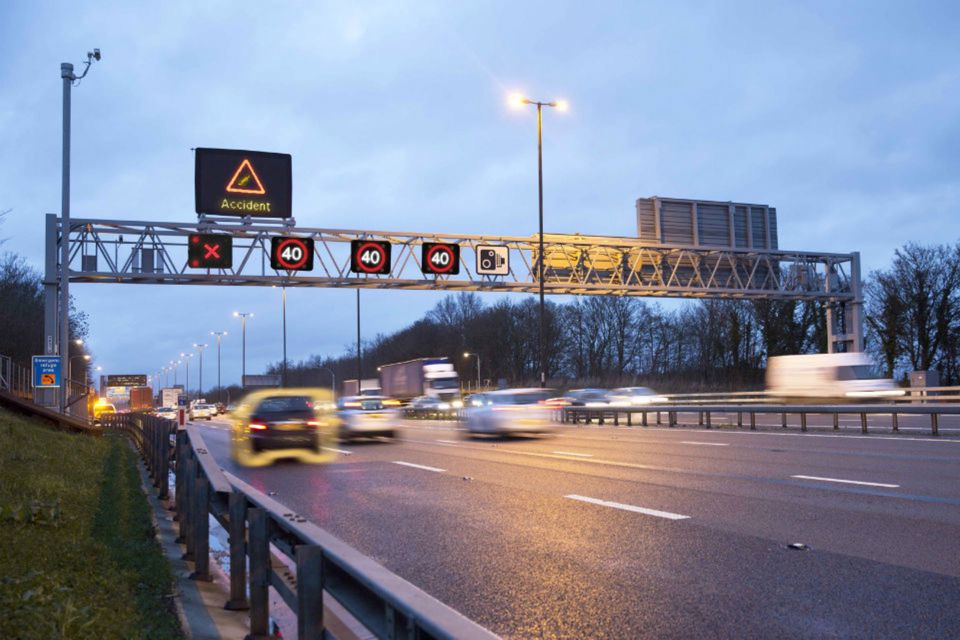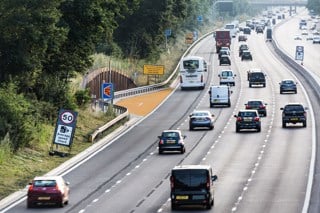Smart motorways are the safest roads in terms of serious and fatal casualties, new data from National Highways suggests.
Outlining its progress on delivering safer smart motorways, National Highways has published an update on the Smart Motorway Stocktake and Action Plan.
It concludes that, compared to other roads in England, all three smart motorway types are performing better than conventional motorways on the casualty-focused fatal and weighted injuries (FWI) and killed and serious injuries (KSI) rates, and much better than A-roads for both collision and casualty rates.
Conventional motorways have lower personal injury collision (PIC) rates than other road types, but as their casualty rates (FWI and KSI) are higher, this suggests that when a collision occurs on a conventional motorway it is more likely that it will involve a killed or seriously injured casualty than a collision on the three smart motorway types.
It also found that, while stopped vehicle collisions remain a very small proportion of all collisions (the proportion ranges from 2.36% for controlled motorways to 2.99% for conventional motorways to 5.26% for all-lane running motorways), stopped vehicle collision and casualty rates are lowest for conventional and controlled motorways.
The risk of an individual experiencing a live lane collision between a moving and a stopped vehicle while still rare, is greater on all-lane running motorways (ALR) and dynamic hard shoulder running (DHS) motorways, but the risk of a collision involving only moving vehicles is lower.
Between 2016 and 2020, the report says that there were 243,701 live lane breakdown incidents reported on the strategic road network (SRN).
Slightly more than half of these took place on conventional motorways, whereas approximately a quarter took place on motorways without a permanent hard shoulder (ALR and DHS).
Nick Harris, chief executive of National Highways, said: “Every road death is a tragedy, and our thoughts are with those who are affected.
“The latest data shows that, overall, in terms of serious or fatal casualties, smart motorways are our safest roads.
“We are continuing our work to make them our safest roads in every way.”
It is now two years since the transport secretary published the smart motorway stocktake and action plan in March 2020.
Over the past year, the Transport Select Committee (TSC) completed its inquiry and published its report into the rollout and safety of smart motorways.
In response to that report, the Government agreed to all of the committee’s recommendations, which included pausing the rollout of new all-lane running (ALR) smart motorways until five years of safety and economic data is available for schemes opened before 2020.
Harris explained that the agency is providing more information to drivers aimed at increasing awareness of how to drive and stay safe on motorways, and by the end of September 2022 it will have stopped vehicle detection (SVD) technology in place on every existing all-lane running smart motorway.
SVD sends alerts to National Highways regional control rooms so operators can close lanes, deploy traffic officers and get help to drivers and their passengers quicker.
By September, it will have also installed additional signs to better inform drivers of the distance to the next place to stop in an emergency and completed the upgrade of all enforcement cameras to enable the detection of Red X violations.
Writing in the report, Harris said: “It remains too early to quantify the effect of these actions, but we will continue to monitor and evaluate the safety of our network over the coming years.
“Any death on our network is one too many, so we will continue to work hard to make our roads as safe as they possibly can be.”
Welcoming the report, Neil Greig, director of policy and research at IAM RoadSmart, said: “We are now seeing the delivery of safety technology that was promised when the motorway designs were first proposed.
“Later this year, every existing smart motorway will have stopped vehicle technology fitted to alert drivers of incidents ahead. Combined with a 50% increase in emergency refuges by the end of 2025, increased signage and upgraded enforcement cameras, smart motorways can now be seen as a much safer way to travel.”
However, he added: “Statistics may show that smart motorways have fewer fatal crashes than conventional motorways, but far too many drivers don’t feel safe on them.
“It is vital that National Highways build on this report to keep the public informed and continue to raise awareness of how to drive safely on smart motorways, so drivers feel confident to use these major national routes rather than avoiding them and travel on riskier A-roads."
RAC head of roads policy Nicholas Lyes also believes the key question is whether these changes are enough to reassure drivers, many of whom firmly believe that removing the hard shoulder compromises safety.
“While the Government is keen to point out that all-lane-running smart motorways tend to have a better overall safety record than conventional motorways, the safety comparisons with other types of smart motorways are less impressive,” he said.
Edmund King, AA president, says that smart motorways should never have been rolled out without these latest safety measures being in place to start with.
“The latest data backs up why we called continuously for more ERAs (emergency refuge areas) and better radar systems," he said.
“The five-year average shows that when a vehicle is stopped in a live lane of any form of smart motorway, it is worse across all safety metrics when compared to a motorway with a permanent hard shoulder.
“We have seen progress with 100-mile roll out of Stopped Vehicle Detection but a recent serious incident on the M3, where a bridge seems to have prevented the radar working, reminds us that it is not infallible.”
























Login to comment
Comments
No comments have been made yet.